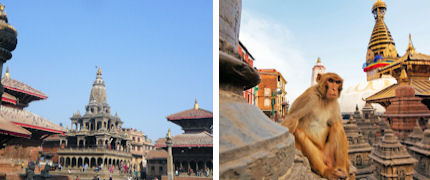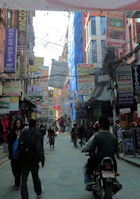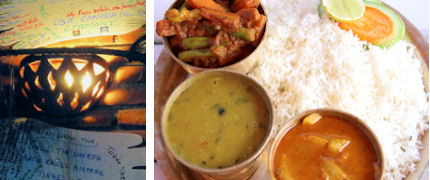24 hours in: Kathmandu
Nepal’s capital Kathmandu feels like a frontier town - raw, authentic and definitely a place for adventurers. Our 24-hour guide will help you tackle one of Southern Asia’s most vibrant cities.
EARLY RISE
First Timers
The early morning is the perfect time to head for perhaps Kathmandu’s most famous site and one of the holiest places for Buddhists – Boudhanath Stupa. A UNESCO World Heritage Site since 1979, a daily ritual for worshippers is to circle the structure as it gleams in the dawn light, spinning prayer wheels and chanting as they turn. Colourful flags adorned with prayers flutter in the breeze and the dome itself – built in the 5th century AD – resonates with hypnotic mantras. You can get coffee from one of the many surrounding restaurants and wander the site, mingling with the faithful. Here you will find some 30 monasteries and convents surrounding the stupa, and dozens of monks and nuns praying and offering services. Incense lingers in the air making the sense of spirituality nearly tangible.
Old Hands
Although the mystical rituals of the east were appropriated by a hippy-ish element of the west, local people have been practising meditation as part of their daily lives for centuries. It’s hardly an affectation to them, but an intrinsic part of existence. Get inspired by the worshipping that takes place around the Boudhanath and participate in a nearby meditation class. Not only monasteries and convents offer early morning contemplation, but many galleries and shops also have drop-in sessions where you’re free to join in a tranquil and reflective start of the day.
MORNING
 Durbar Square and a monkey perched at Swayambhunath Stupa
Durbar Square and a monkey perched at Swayambhunath Stupa WTG Paul Oswell / Thinkstock iStockphoto
First Timers
Before the unification of the country in the mid 18th century, Nepal was ruled by regal factions, and the various entities all had royal plazas that were known as Durbar Squares. The best example is Kathmandu Durbar Square, one of three main city squares and a UNESCO World Heritage Site where you can revel at temples, royal mansions and courtyards. The Hanuman Dhoka Palace is one of the most imposing buildings, named after a monkey god, represented by a huge stone statue. The array of temples is impressive, with most of the structures dating back to the mid 16th century. Kumari Temple is perhaps the best example of the artistry on display here, though you’re virtually surrounded by carved wooden struts and beautiful latticed windows.
Old Hands
Equally as holy as Boudhanath but with slightly more wildlife is the primate-friendly temple of Swayambhunath, otherwise known as the Monkey Temple. After a short taxi ride to the western suburbs of Kathmandu, you’ll arrive at a complex of shrines and stupas. If you’re feeling energetic, then take the 300-odd steps up to the main temple, but if you’re still wiping the cobwebs of sleep away there’s a road that you can ask your driver to take. The design is similar to Boudhanath with a shining dome, atop from which peek out the eyes of Buddha. Look out for intricate carvings around the side of the main stupa, as well as gilded lions that guard the entrance.
AFTERNOON
First Timers
 Get lost in the busy streets of Thamel
Get lost in the busy streets of ThamelWTG / Paul Oswell
If Kathmandu can be said to have a downtown in the Western sense, then Thamel is that neighbourhood. The grid of busy streets developed in the 1960s and 70s when the city became popular for Westerners on a bohemian jaunt. It is now a heaving slice of consumerism with shops, travel agencies, massage parlours and galleries teeming throughout the narrow streets. There are a wealth of shops selling equipment and discount fleeces aimed at passing tourists about to embark on mountain expeditions. A walk down Freak Street is particularly touristy, but it’s a glimpse of Kathmandu life where you can pick up everything from Darjeeling tea to Ghurka knives. The street food here is generally good, so try dal (lentil soup) and Nepal’s most famous dish – momo (dumpling).
Old Hands
Although Kathmandu can boast many things, sophistication isn’t generally one of them. The city has the feeling of a frontier town, and that sense of authenticity is what draws many people here. That isn’t to say you shouldn’t seek out an elegant respite, such as the Garden of Dreams on the edges of Thamel. For a small fee, you can walk into the plush surroundings of a neo-classical garden where young couples whisper sweet nothings in the hidden corners. The entire garden is a triumph of design, with pavilions, pergolas and birdhouses. Laze next to one of the fountains or take afternoon tea at any of the on-site restaurants. It’s hard to believe you’re in the middle of a bustling urban menagerie and not in the private grounds of a European monarch.
EVENING
 White footprints on the walls of The Rum Doodle and a traditional Nepalese dish
White footprints on the walls of The Rum Doodle and a traditional Nepalese dish Creative Commons Stephen A. Wolfe / Thinkstock iStockphoto
First Timers
It’s easy to get a free meal in Kathmandu. You just have to have scaled Everest, that’s all. So goes the promise at the city’s most famous eatery, The Rum Doodle. The food and cocktails – though appetising – play a second place to the tales of daring and glorious ascents of years gone by. The entire place is a testament to the great adventurers of the region. Large, white cut-out footprints line the entrance, collected over the decades. Boxes behind the bar are covered in signatures, a collection started many years ago by the autograph of one Sir Edmond Hillary. As well as being one of the city’s finer dining establishments, The Rum Doodle has a sense of the whimsical as well as the legendary.
Old Hands
If you’ve had your fill of street food and want to indulge more refined tastes then take a taxi to the mysterious complex of Dwarika’s Hotel. The entire hotel is constructed from ancient wooden beams, with dark edifices looming over candle-lit courtyards. After a stroll around the grounds, sit down to a thoroughly regal dining experience at Krishnarpan. It’s a slow-food concept with the very best in Nepali cuisine, prepared from the hotel’s own organic farms. Take a six-course journey, or the epic adventure of 22 courses – all served in antique earthenware as you sit cross-legged at the low wooden tables. Fit for a king or queen indeed – there’s almost enough food for an entire royal household.
Do you have any Feedback about this page?
© 2026 Columbus Travel Media Ltd. All rights reserved. No part of this site may be reproduced without our written permission, click here for information on Columbus Content Solutions.









 You know where
You know where